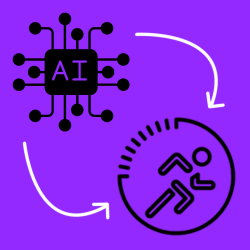BLOG
Fear (less) Factors that Make AI a Strategic and Supportive Addition to Activation

You’ve seen the headlines:
AI is coming to a business near you.
AI is after your job.
If you’re human-look out!
It’s no surprise that conversations concerning AI and machine learning make us nervous; Implementation of these tools is hitting the scene hard and fast with lofty predictions for transforming all aspects of business operations.
A recent Forbes survey found that around 77% of people are concerned about losing their jobs to AI technology in the next year. However the majority of companies ( 97%) recognize the need to implement AI and automation into their operations, but not at the expense of the employee experience.
The truth is that tools like ChatGPT and AI can be a strategic partner in implementing digital transformation, and change management is essential for helping stakeholders understand every step of that process, recognize the value these integrations bring to their team’s productivity, and encourage effective adoption of AI.
Much like AI is constantly gathering and analyzing new data, the work culture should reflect one of constant learning. Tech editor Tom Stone summed it up. “While systems continue to learn, human interactions are required to make them more efficient, accurate and relevant in our world. Human validation of processes must continue to ensure that the technology is assisting the customer.”
How can companies find a winning formula? That’s the focus of Thunder’s AI Activation.
When partnered with an experienced change management team, incorporating AI technology into work processes doesn’t mean an inevitable onslaught of pink slips for valued employees. Instead, assessing AI-generated data can enhance workflow and add value to the job by measuring the impact of transformation, offering a roadmap that helps teams visualize these innovations, and opening doors for honest employee feedback from those most impacted.
Let’s discuss three primary strategies our AI Activation team uses to leverage AI while preparing for user adoption.
1. Set clear business objectives
What is the practical purpose of this change? Is it to streamline sales or subscription services with automated tasks? Improve shipping processes with self-service portals? What are the goals for implementing AI? How will it look to the end user? Moreover, what does your data show?
Examining AI-supported data can measure different factors that impact the outcome of these initiatives. From this perspective, stakeholders can identify competitive opportunities and potential challenges based on projected market conditions, evolving customer expectations, economic conditions, and other factors influencing business objectives. When these goals are established, it’s time to share the vision of AI-supported operations.
2. Be transparent about changes
Most business owners are optimistic about AI’s impact. Over half (64%) believe that AI will improve productivity, and around 60% believe that personalization capabilities will enhance customer relationships.
Don’t just tell stakeholders what AI can do to improve operations—show them. Invite employees and stakeholders to test platform demos, for example. Then, prepare for a flurry of feedback.
3. Encourage feedback
Although stakeholders should have considered changes in the initial stages of implementation, employees should feel welcome to share feedback. AI-powered communication tools can facilitate transparent communication between employees, management, and stakeholders. Chatbots, virtual assistants, and other AI-driven platforms can provide consistent and timely information about the digital transformation journey.
The overall feel of AI services is positive, but that doesn’t mean it won’t change how employees interact or perform job duties. Fortunately, with this feedback data, managers can track trends and extend support, training and other professional growth opportunities to address specific concerns.
4. Transition to a culture of continuous learning and training
As more companies implement AI into the workplace, many discover that AI works best as augmented intelligence rather than a total replacement of an essential work function.
“The true purpose of generative AI isn’t to replace humans, but to help humans do what we do best: make strategic, value-adding decisions,” said Eilon Reshef, co-founder and CPO of Gong.io. “Thus, you should look for ways for generative AI to optimize your daily workflow.”
The nervousness surrounding AI is a testament to the profound impact it holds. It prompts us to ask critical questions, engage in thoughtful discussions, and establish frameworks that guide responsible AI implementation.
The conversations surrounding AI and machine learning are not just about embracing the future; they are about navigating a complex landscape of innovation, ethical considerations, and the need for adaptability.
The Thunder AI Activation team works hard to approach every opportunity with a balanced perspective that leverages AI capabilities and machine learning while addressing the concerns they raise. If your company is ready to embark on the AI journey, let’s walk it together.
Contact us to learn about how AI can help with your Salesforce Activation!
Ready to Start Loving Salesforce?
Contact us today to learn how we can help make Salesforce your business’s unfair advantage.
Quick links
Quick contact
-
Thunder
548 Market Street PBM 88159
San Francisco, CA 94104 - Contact Us
All rights reserved © 2025

